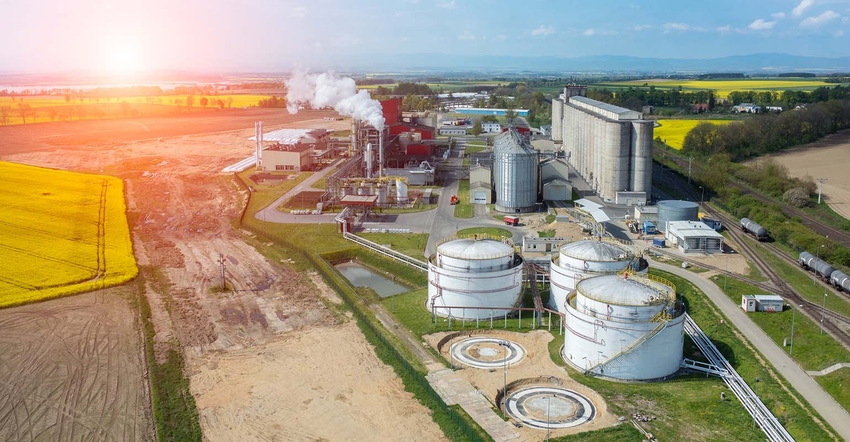EPA expected to mandate use of 15 billion gallons of renewable fuels
The administration is trying to balance the needs of Midwest farmers and oil refiners.

by Jennifer A. Dlouhy and Mario Parker
The Trump administration is set to keep biofuel quotas for motor vehicles largely unchanged, a move likely to draw tepid applause from Iowa corn growers and disappoint soy-based biodiesel producers.
The Environmental Protection Agency will mandate refiners use 15 billion gallons of conventional renewable fuels -- primarily ethanol -- next year, in a final rule set to be issued Thursday, according to an EPA official. But, rebuffing pleas from biodiesel producers, the agency also is set to maintain a 2.1-billion-gallon quota for that soy-based fuel in 2019, the official said. The official asked not to be identified discussing the regulation before its release.
The final rule shows EPA "is listening to our concerns and taking them into consideration, but it also shows that we have more work to do," Iowa Governor Kim Reynolds said in an emailed statement. The agency is "discouraging investment and discouraging growth" by keeping biodiesel volumes flat, she added.
The EPA’s decision illustrates how the administration is trying to balance the needs of two competing constituencies for President Donald Trump: Midwest farmers who rely on the mandate to guarantee ethanol demand and oil refiners that insist the requirements are costly, burdensome and impractical.
For more than a decade, federal law has compelled refiners to use renewable fuel -- up to 36 billion gallons in 2022 -- but tasked the EPA with setting the precise annual quotas. Many lawmakers supported the Renewable Fuel Standard with the expectation that first-generation corn-based ethanol would be replaced by alternatives made from corn stalks, algae or other materials such as switchgrass.
Overall Mandate
The EPA is set to require 4.29 billion gallons of advanced biofuel in 2018, a slight uptick from the current 4.28-billion-gallon quota and a 4.24 billion gallon proposal the agency outlined in July.
At least 288 million gallons of that would have to be the cellulosic biofuel from non-edible plant materials, below the current 311-million-gallon quota. That’s a modest increase from the EPA’s initial 238-million-gallon proposal. Production of cellulosic ethanol has lagged far behind what the measure’s supporters envisioned a decade ago.
Brooke Coleman, head of the Advanced Biofuels Business Council, said the EPA’s targets "miss a valuable opportunity to accelerate growth" in cellulosic ethanol production by keeping levels below the 2017 quota.
"Unwarranted cuts to cellulosic biofuel targets send the wrong signal to global investors in this emerging industry," Coleman said by email.
Biodiesel production also has grown, and EPA is set to disappoint those producers in keeping the mandate steady at 2.1 billion gallons.
Biodiesel advocates had argued that number fell far short of potential production, with the industry’s leading trade group pushing for a 2.5 billion gallon target in a Nov. 16 letter to Trump. The proposed -- and now final -- 2.1 billion gallon quota is so low that it’s "sending the wrong signal to an industry poised for robust, sustainable growth," the National Biodiesel Board wrote.
Members of that industry trade group swarmed Capitol Hill this week to voice their concerns with the earlier proposal. Industry officials argue they have current capacity to produce 2.6 billion gallons of biodiesel. And they argue that the production of ethanol and biodiesel are increasingly linked, especially as more biodiesel is made using corn oil, an ethanol byproduct.
Senator Chuck Grassley, a Republican from Iowa, said he was disappointed by the lack of an increase in biodiesel levels and the cut in the quota for cellulosic ethanol, especially when "increases are justified."
"This final rule does little to encourage investment and growth in advanced biofuels," Grassley said in an emailed statement. By contrast, "Congress intended for the RFS to drive growth in biofuels across all categories."
The 15-billion-gallon quota for conventional renewable fuel mirrors the current target and sets up a disappointment for oil refiners that had argued that amount would exceed a 10% "blend wall," or the amount that can be easily blended into the fuel supply.
EPA Administrator Scott Pruitt previously committed to set final quotas at levels "equal to or greater than the proposed amounts." That concession came in an October letter to farm-state senators after they agreed to stop blocking the confirmation of a top EPA official over possible changes that could undermine the biofuel mandate.
The final plan shows Pruitt sticking by that pledge -- but not making aggressive moves to go beyond it.
Trump visited ethanol plants while campaigning for president and promised Iowa’s voters he would protect the mandate if they elected him.
Pruitt is scheduled to meet with farmers and biofuel groups in Nevada, Iowa, on Friday, according to people familiar with the meeting, who asked not to be named because the details haven’t been made public.
--With assistance from Ari Natter.
To contact the reporters on this story: Jennifer A. Dlouhy in Washington at [email protected]; Mario Parker in Chicago at [email protected]
To contact the editors responsible for this story: Jon Morgan at [email protected]
Mark Drajem, Elizabeth Wasserman
© 2017 Bloomberg L.P
About the Author(s)
You May Also Like

.png?width=300&auto=webp&quality=80&disable=upscale)

